Ever had that awkward moment when your perfectly grilled steak tastes oddly metallic because you paired it with the wrong beer? Don’t worry, you’re not alone. 87% of beer drinkers unknowingly sabotage their meals with mismatched brews. The art of pairing beer with meals isn’t just for pretentious foodies – it’s for anyone who wants food that actually tastes better, not worse, after taking a sip.
⚠️ Alcohol Content Disclaimer: GetUrDrinkOn.com features content related to alcoholic beverages and mixology. All content is intended for informational and entertainment purposes only. We do not sell alcohol or promote underage or irresponsible drinking. This site is intended for adults aged—21 and over in the United States, and 18 and over in most other countries. Please drink responsibly. If you or someone you know is struggling with alcohol use, please seek professional help.
Think about it: you wouldn’t wear flip-flops to a snowstorm, so why force a delicate fish to compete with an aggressive double IPA? Getting beer and food pairings right can transform an ordinary Tuesday dinner into something memorable.
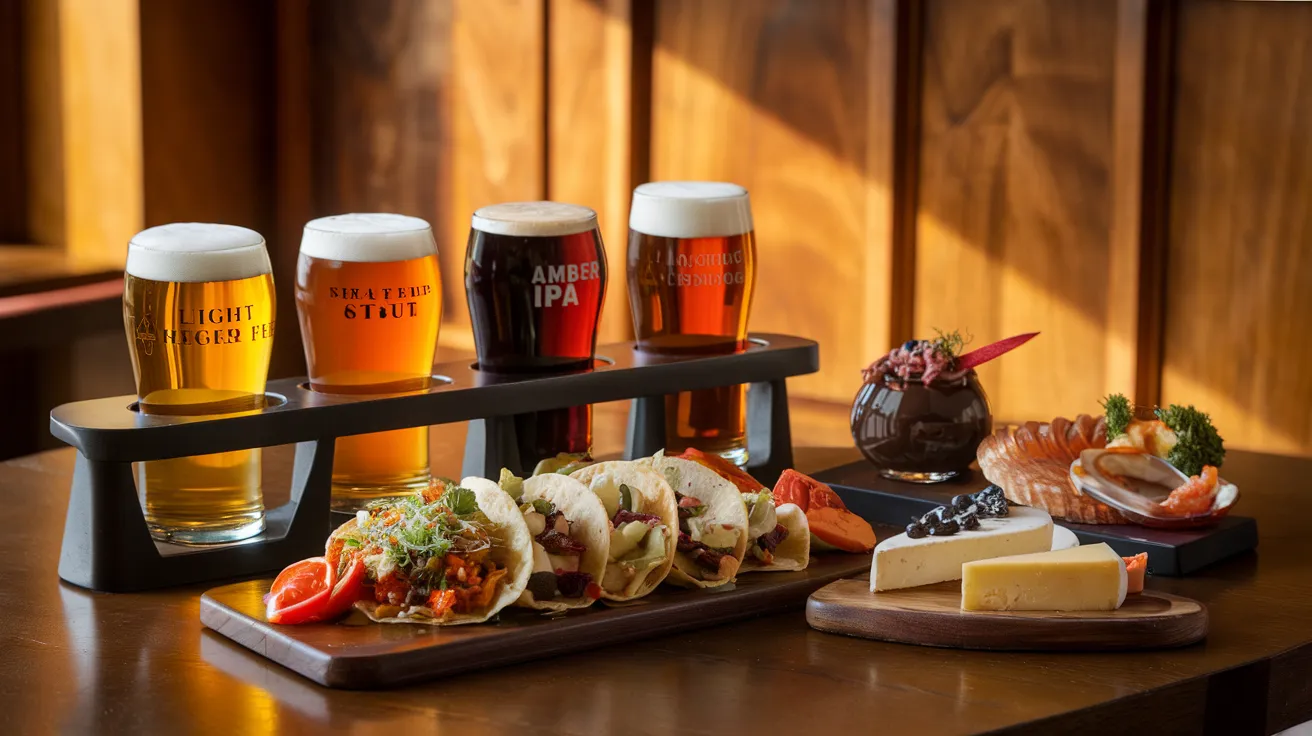
I’m about to share the insider rules that craft brewers and chefs use to create those “wow” moments when beer and food meet. But first, let me tell you about the pairing mistake that’s ruining your burger nights…
👉 Upgrade your home whiskey setup with the sleek and functional 🛒 Zarler Bar Cart Bar Table with LED lighting, power outlet, and 4-tier liquor storage—perfect for any modern home bar.
Understanding Beer Basics for Pairing Success
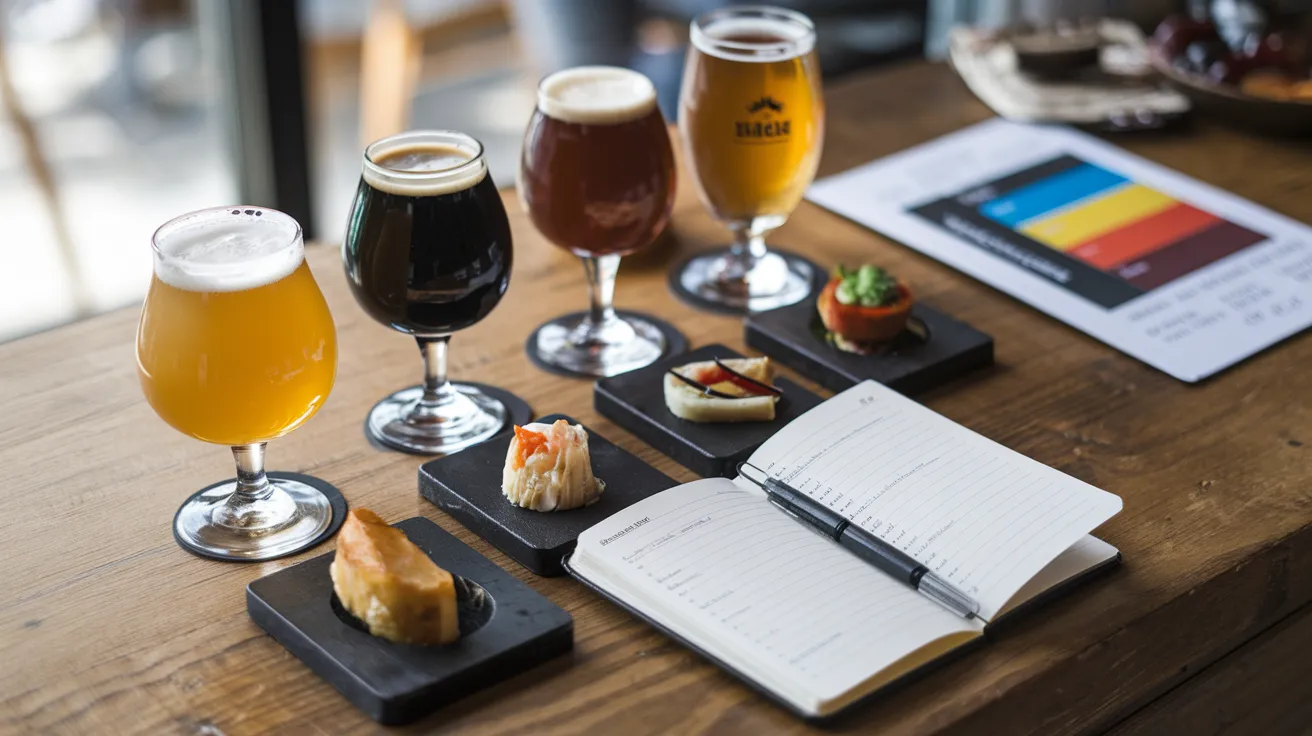
Key flavor profiles: hoppy, malty, fruity, and sour
Ever tasted a beer and thought, “Wow, that’s bitter!” or “This is kinda sweet”? You’re picking up on beer’s basic flavor profiles. These are your building blocks for killer food pairings.
Hoppy beers like IPAs pack that bitter punch with citrus or pine notes. They cut through fatty foods beautifully – think spicy wings or a juicy burger.
Malty beers bring sweetness and toasty flavors. Your amber ales and brown ales fall here. They’re your best friends for roasted meats and BBQ.
Fruity beers (Belgian styles and wheat beers) offer banana, clove, or actual fruit flavors. Pair them with salads, seafood, or even desserts.
Sour beers hit you with tartness that works magic with rich, creamy foods. They reset your palate between bites of something like a creamy risotto.
How alcohol content impacts food pairing
The alcohol percentage isn’t just about how quickly you’ll feel it – it affects flavor matching too.
Lower ABV beers (under 5%) won’t overwhelm delicate dishes. They’re perfect for salads, light seafood, or appetizers.
Mid-range beers (5-7%) are your versatile players – good with most main courses.
High-alcohol beers (8%+) stand up to bold, rich foods. Those imperial stouts? Made for chocolate desserts or strong cheeses.
The importance of beer temperature when serving
Serving beer at the right temperature isn’t beer snobbery – it’s about maximizing flavor.
Cold temperatures (38-45°F) work for lighter beers like lagers and pilsners, making them crisp and refreshing.
Amber ales and IPAs need slightly warmer temps (45-50°F) to let their flavors bloom.
Dark beers and strong ales taste best at “cellar temperature” (50-55°F), revealing complex notes that cold would hide.
Too cold? You’ll miss flavors. Too warm? You’ll get excessive bitterness or booziness.
Classic Beer and Food Pairings That Always Work
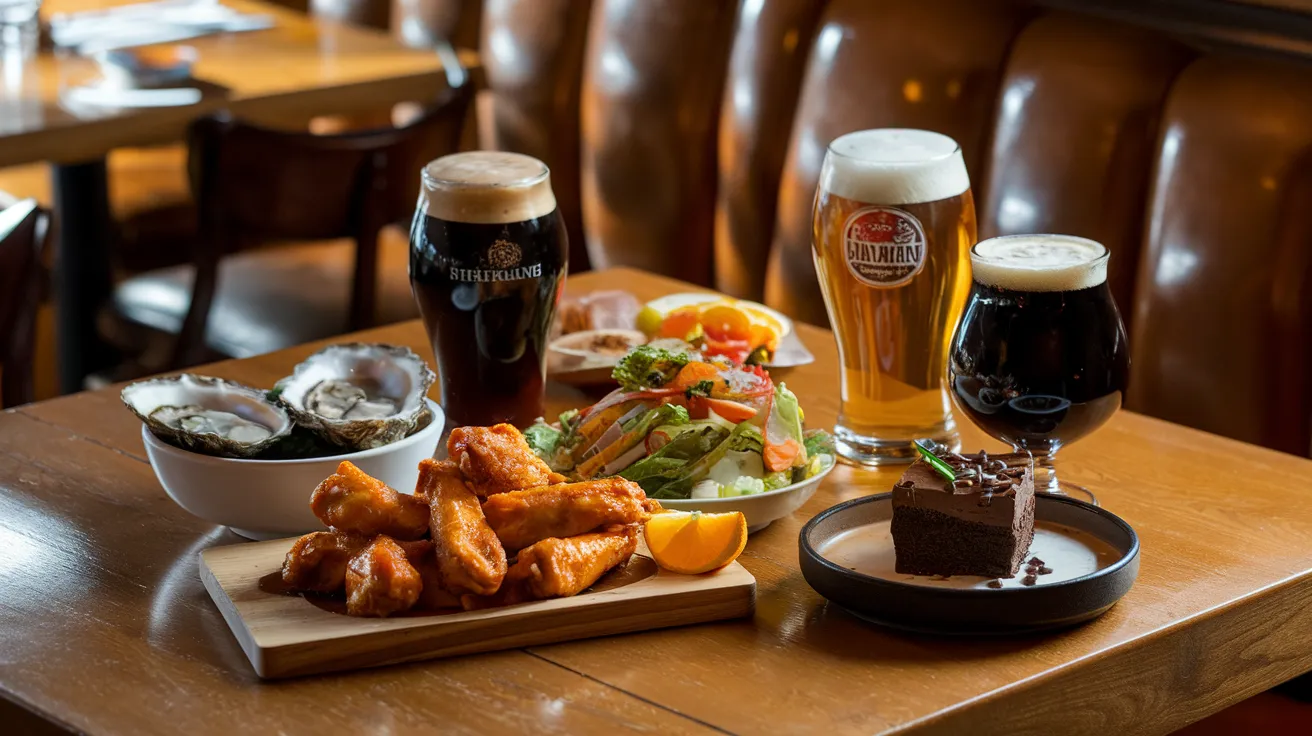
Classic Beer and Food Pairings That Always Work
Light lagers with delicate dishes
Ever noticed how a crisp Pilsner or light lager just feels right with certain foods? That’s no accident. These beers have a clean, refreshing character that won’t overpower mild-flavored dishes. Try pairing a Corona or Stella Artois with sushi, garden salads, or light chicken dishes. The subtle hop bitterness cuts through the fat while the carbonation cleanses your palate between bites.
IPAs with spicy cuisines
IPAs and spicy food? Match made in heaven. The bold hop profile in India Pale Ales stands up beautifully to the heat in Mexican, Thai, or Indian dishes. The beer’s bitterness actually cools your mouth after those spicy bites, while the citrusy notes complement the complex spice blends. Next taco night, grab a Sierra Nevada or Lagunitas IPA and watch the magic happen.
Stouts with chocolate desserts
Dark, rich stouts and chocolate desserts create flavor fireworks. The roasted malts in Guinness or chocolate stouts mirror the deep cocoa notes in brownies, chocolate cake, or mousse. Both have similar flavor compounds that amplify each other – coffee, caramel, and that slight bitterness that keeps sweet desserts from becoming cloying.
Wheat beers with seafood
Wheat beers bring a light, citrusy vibe that’s perfect with seafood. The subtle sweetness and bright notes in a Hefeweizen or Blue Moon complement delicate fish flavors without overwhelming them. Plus, that squeeze of orange often served with wheat beers? It’s basically built-in seafood seasoning.
Belgian ales with cheese plates
Belgian ales and cheese boards are basically best friends. The fruity esters and spicy phenols in Chimay or Duvel create fascinating contrasts with funky cheese. Soft cheeses melt beautifully against the carbonation, while aged cheddars find their match in the beer’s complex flavor profile.
Pairing Principles to Elevate Your Dining Experience
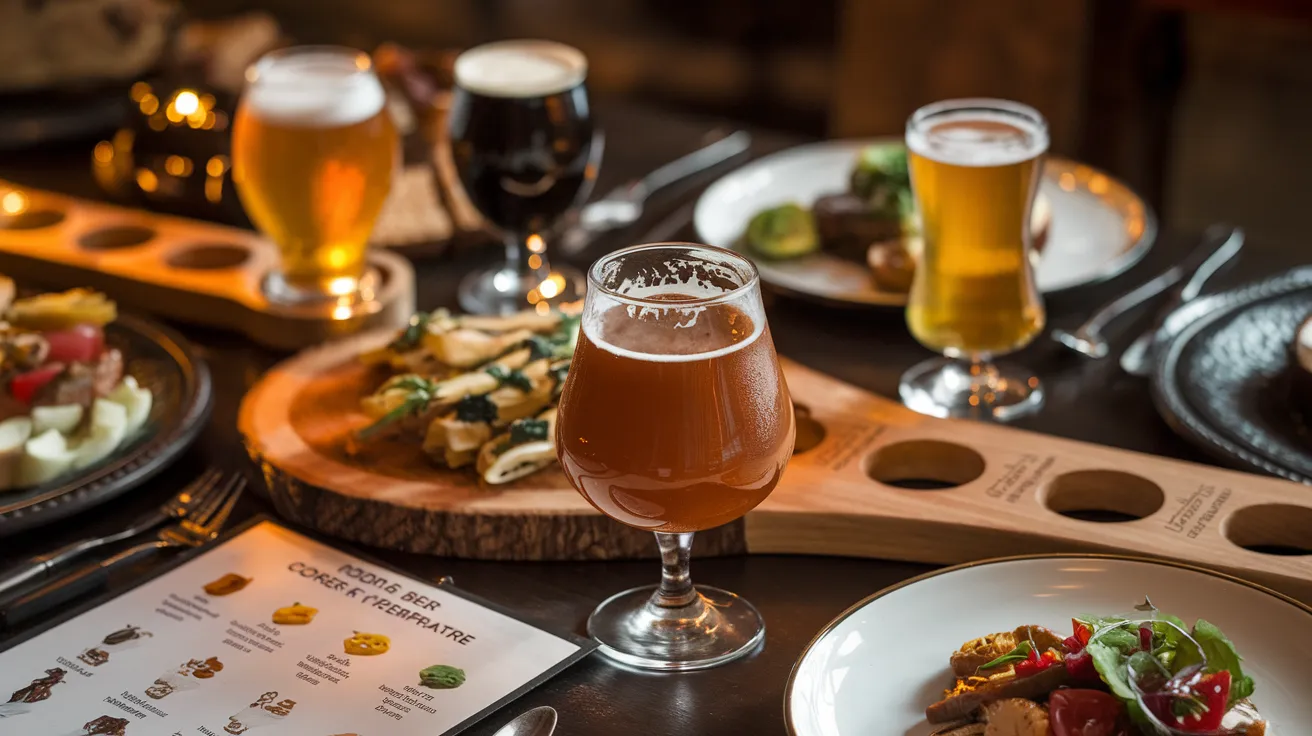
Complement vs. contrast strategies
Ever noticed how certain foods just sing with specific beers? That’s no accident. When pairing beer with food, you’ve got two main approaches: complement or contrast.
Complementary pairing means matching similar flavor profiles. Think of a nutty brown ale with a mushroom risotto – both share earthy, umami notes that amplify each other. Or try a citrusy wheat beer with seafood – the bright flavors enhance the ocean freshness.
Contrast pairing creates excitement through opposition. A hoppy IPA cuts through fatty barbecue like a charm. The bitterness literally scrubs your palate clean between bites. A sweet Belgian dubbel alongside spicy Thai food? Magic – the malty sweetness cools the heat.
Matching intensity levels between beer and food
The golden rule of beer pairing? Match the weight of your beer with your food. Heavy dishes need robust beers. Light foods need delicate beers.
A imperial stout would crush a delicate salad, while a light pilsner disappears against a rich steak. Your beer and food should be dance partners of equal strength.
Here’s a quick intensity guide:
| Food Intensity | Beer Match |
|---|---|
| Light (salads, fish) | Pilsners, blonde ales, hefeweizens |
| Medium (chicken, pasta) | Amber ales, IPAs, saisons |
| Heavy (steak, stews) | Porters, stouts, barleywines |
Regional pairing traditions worth following
The Belgians nailed it centuries ago – Belgian ales with mussels creates flavor harmony you can’t ignore. Germans understood that crisp lagers perfectly balance fatty sausages and pretzels.
English bitter ales with fish and chips? That’s not just tradition – it’s genius. The malt sweetness complements the batter while the hops cut through grease.
Mexican cuisine practically begs for Vienna lagers (think Negra Modelo with mole sauce). The caramel notes in the beer highlight similar flavors in complex sauces.
These traditions evolved through generations of trial and error. They simply work.
Seasonal Pairing Approaches
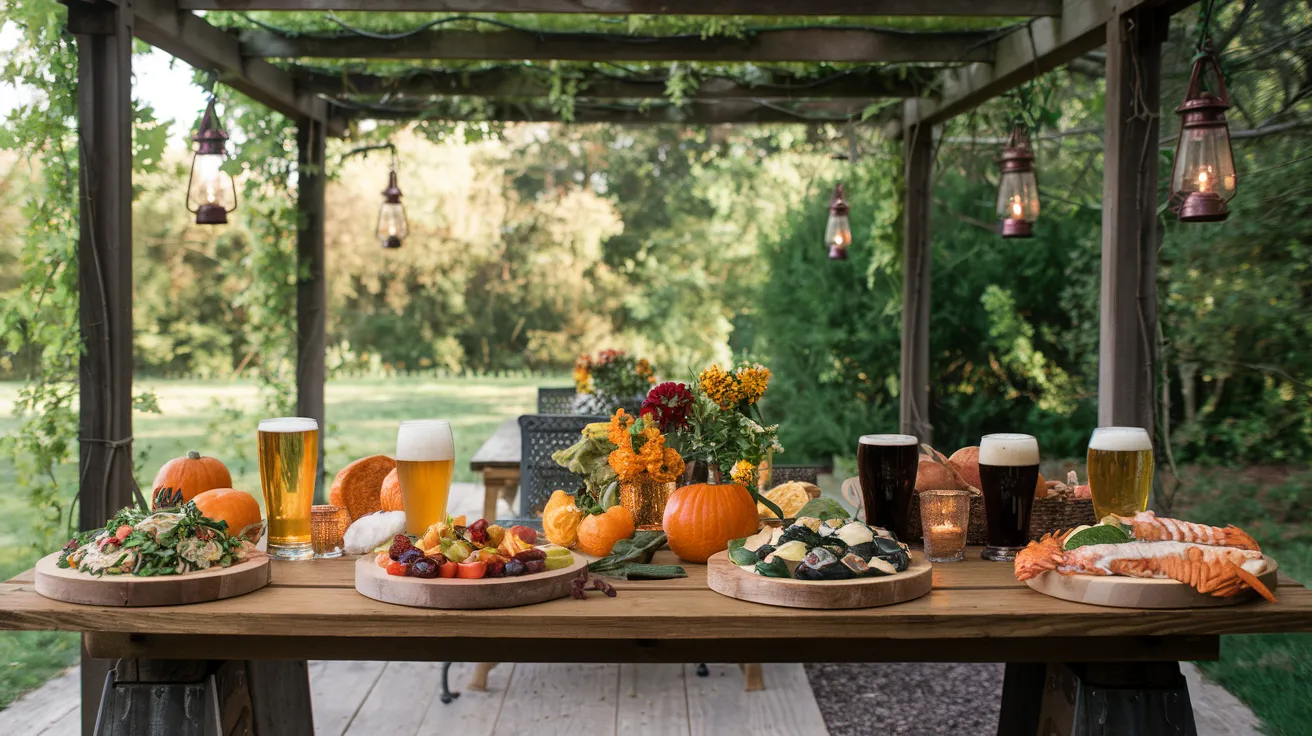
Summer beers and grilled favorites
Beer and grilling go together like summer and sunshine. When you’ve got those burgers sizzling on the grill, reach for a crisp American Pale Ale. The hoppy notes cut through fatty meats while complementing the smoky char.
Grilled chicken? Grab a wheat beer. The light, citrusy flavors won’t overpower your poultry but will refresh your palate between bites. And for those spicy BBQ ribs, nothing beats an IPA – the bitterness balances the sweet sauce perfectly.
Don’t forget seafood! A light pilsner alongside grilled shrimp or fish tacos is practically heaven. The clean finish rinses away fishiness while highlighting delicate ocean flavors.
Fall harvest pairings with amber ales
Fall brings harvest flavors, and amber ales step up beautifully here. Their caramel notes mirror the sweetness in roasted root vegetables and squash dishes.
Tried pairing an amber ale with butternut squash soup? The nutty malts in the beer enhance the soup’s earthiness. Same goes for mushroom dishes – the beer’s toasty character brings out those umami flavors.
Game meats like venison practically beg for amber ales. The beer’s slight sweetness tames the meat’s gaminess while its medium body stands up to rich textures.
Winter warmers with hearty comfort foods
Cold nights call for strong beers. Imperial stouts and barleywines become your best friends with their higher alcohol content and complex flavors.
Beef stew with a porter is pure magic – the beer’s roasted notes complement the browned meat while its subtle chocolate undertones add depth. For holiday hams, try Belgian dubbels whose fruity esters play nicely with the sweet glaze.
Cheese fondue meets its match in a bock beer. The malty sweetness cuts through the richness while the clean finish prepares you for the next bite.
Spring pairings with fresh, lighter dishes
Spring calls for beers as bright as the season. Saisons work wonders with herb-forward dishes – their peppery, farmhouse character amplifies fresh herbs in salads and light pastas.
Asparagus (notoriously tough to pair with wine) finds harmony with Belgian witbier. The beer’s coriander and orange peel notes complement the vegetable’s grassy character instead of fighting it.
For spring lamb, reach for a Märzen. Its toasty character stands up to the meat while remaining light enough for the season.
Hosting a Beer Pairing Dinner Party
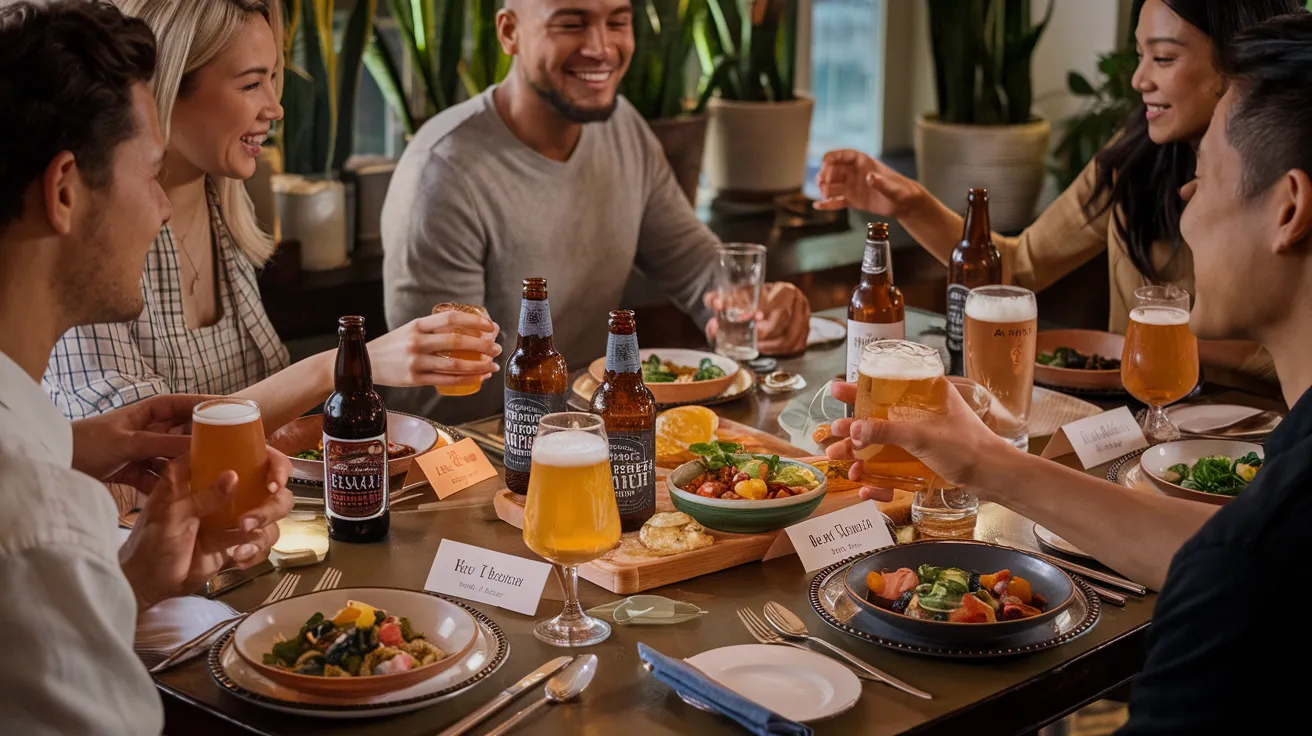
Creating a tasting menu that impresses guests
Want to blow your friends’ minds at your next dinner party? A beer pairing menu is your secret weapon. Start with something light and refreshing like a witbier paired with a citrusy salad. This opens up the palate without overwhelming it.
Move to more substantial flavors gradually. Try a hoppy IPA with spicy buffalo wings or a rich porter with chocolate dessert. The magic happens when the beer either complements or contrasts with the food.
Here’s a simple structure that works every time:
- Course 1: Light beer + light appetizer
- Course 2: Medium-bodied beer + main dish
- Course 3: Bold beer + rich dessert
Don’t overthink it. Pick 3-4 solid pairings rather than cramming in too many options.
Proper glassware selection for different beer styles
The right glass isn’t just fancy party tricks – it actually impacts flavor. Different shapes capture aromas and affect head retention, completely changing how you experience the beer.
| Beer Style | Ideal Glass | Why It Works |
|---|---|---|
| Pilsners/Lagers | Pilsner glass | Showcases clarity, maintains carbonation |
| IPAs | IPA glass | Captures hop aromas, directs to nose |
| Belgian ales | Tulip glass | Traps complex aromas, supports head |
| Stouts/Porters | Snifter | Concentrates rich aromas, warms in hand |
No need to break the bank on specialty glassware. Start with tulip glasses – they’re versatile enough to handle most beers respectably.
Portion planning for multiple courses
Beer dinners aren’t about getting hammered. They’re about tasting. Keep pours small – 4-5 ounces per course is plenty. This lets guests experience multiple beers without getting tipsy too quickly.
For food, think tasting portions rather than full meals. About 2-3 ounces of protein per course and appropriate sides works well. This keeps the focus on the pairing experience rather than getting stuffed.
💡 Pro tip: Space courses about 15-20 minutes apart. This gives everyone time to discuss the pairing and cleanse their palates.
Tasting notes template for guests
Give your guests a simple sheet to track their tasting journey. Nothing kills the vibe faster than overcomplicated tasting sheets with too many categories.
Keep it basic with:
- Beer name and style
- Food pairing
- Appearance notes
- Aroma impressions
- Flavor observations
- Pairing success rating (1-5)
- Personal comments
Add a fun element by having guests vote on their favorite pairing of the night. This sparks conversation and gives you feedback for your next beer dinner. The goal isn’t to turn everyone into certified beer judges – it’s to help them notice and appreciate flavors they might otherwise miss.
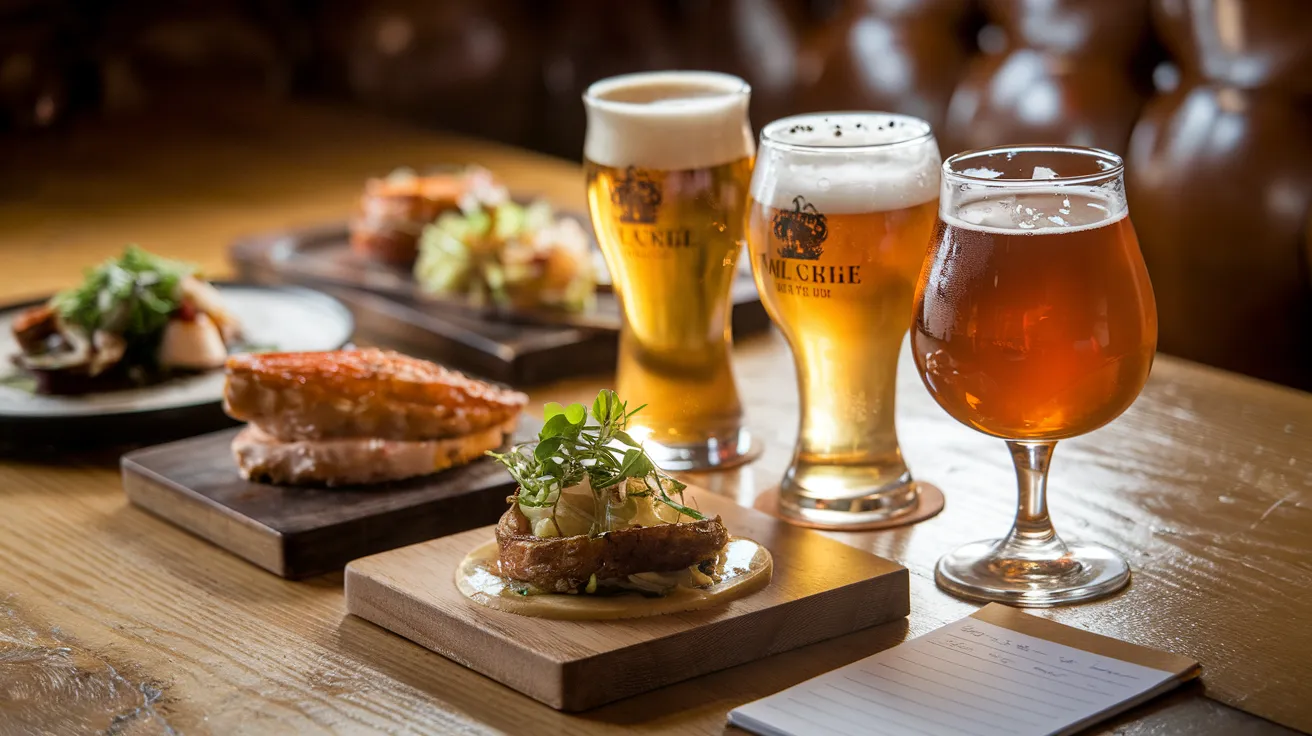
Mastering the art of beer pairing transforms ordinary meals into extraordinary culinary experiences. By understanding beer basics, exploring classic combinations, and applying fundamental pairing principles, you can create harmonious flavor profiles that enhance both the beer and the food. Whether you’re matching light lagers with seafood or robust stouts with chocolate desserts, each pairing offers a new opportunity to discover unexpected and delightful flavor interactions.
Take your newfound knowledge and experiment with seasonal approaches and dinner party hosting. Start small with a few trusted pairings, then gradually expand your repertoire as your confidence grows. Remember, the best pairing is ultimately the one you enjoy most—trust your palate and don’t be afraid to break conventions when your taste buds lead you in new directions. Cheers to your beer pairing adventures!
👉 Master your craft with 🛒 The Art of Mixology: Classic Cocktails and Curious Concoctions—a beautifully illustrated cocktail recipe book perfect for home bartenders and mixology enthusiasts.
📌 Related Read: Beer and Your Health: The Science Behind Moderate Consumption
Join the Conversation!
Drop your thoughts in the comments below and let’s chat about all things beverage!
Frequently Asked Questions (FAQ)
Hoppy beers like IPAs are ideal for spicy dishes. Their bitterness cools the heat and citrus notes complement bold spices found in Thai, Indian, or Mexican cuisine.
Wheat beers and pilsners pair well with seafood. Their light, citrusy profiles enhance delicate fish flavors without overpowering them.
Belgian ales are excellent with cheese. Their fruity and spicy notes balance funky cheeses, and their carbonation refreshes the palate between bites.
Serving beer at the right temperature enhances its flavor. Lighter beers taste best colder, while darker or stronger ales need warmth to unlock complexity.
Yes! Choose 3–4 courses with complementary or contrasting pairings, use proper glassware, and keep pours around 4–5 oz to pace your guests effectively.
Complement pairings match similar flavors (like malty beer with roasted meats), while contrast pairings highlight differences (like IPA with creamy cheese) for complexity.
Yes, seasonal ingredients and weather influence pairings. For example, amber ales suit fall harvest dishes, while wheat beers work best in spring and summer.



